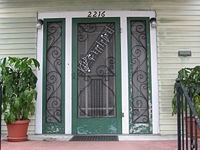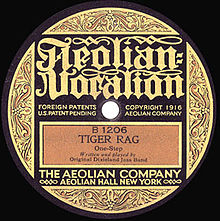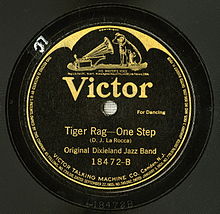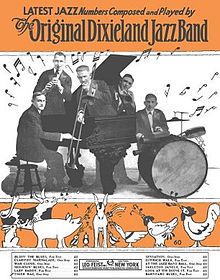- Tiger Rag
-
"Hold That Tiger" redirects here. For the Sonic Youth album, see Hold That Tiger (album).This article is about the tune. For the flag named "Tiger Rag", see Battle for the Rag.
"Tiger Rag" is a jazz standard, originally recorded and copyrighted by the Original Dixieland Jass Band in 1917. It is one of the most recorded jazz compositions of all time.
Contents
Origins
 Front door of Nick LaRocca's house in Uptown New Orleans has the opening notes of "Tiger Rag" in the door screen
Front door of Nick LaRocca's house in Uptown New Orleans has the opening notes of "Tiger Rag" in the door screen
The tune was first recorded on 17 August 1917 by the Original Dixieland Jass Band for Aeolian-Vocalion Records (the band did not use the Jazz spelling until later in 1917) and released as B1206, "Tiger Rag One-Step Written and Played by Original Dixieland Jass Band", backed with "Ostrich Walk".[1] The Aeolian Vocalion sides did not sell well, as they were recorded in a vertical format becoming obsolete at the time which could not be played successfully on most contemporary phonographs.
Their second recording of the tune on 25 March 1918 for Victor Records, 18472-B, backed with "Skeleton Jangle" as the A side, on the other hand, was a smash national hit and established the tune as a jazz standard.[2] The song was copyrighted, published, and credited to bandmembers Nick LaRocca, Eddie Edwards, Henry Ragas, Tony Sbarbaro, and Larry Shields in 1917. Harry DaCosta later wrote lyrics to the instrumental when it became a million- seller and a no. 1 national hit for The Mills Brothers in 1931.
No one was ever able to challenge the authorship of the song "Tiger Rag" by the ODJB. "But even before the first recording, several musicians had achieved prominence as leading jazz performers, and several numbers of what was to become the standard repertoire had already been developed. "Tiger Rag" and "Oh Didn't He Ramble" were played long before the first jazz recording, and the names of Buddy Bolden, Jelly Roll Morton, Bunk Johnson, Papa Celestin, Sidney Bechet, King Oliver, Freddie Keppard, Kid Ory, and Papa Laine were already well known to the jazz community." [3]
Other New Orleans, Louisiana musicians claimed but never proved, however, that the tune had been a standard in the city even before. Some others even copyrighted the same melody or close variations on it under their own names, including Ray Lopez under the title "Weary Weasel" and Johnny DeDroit under the title "Number Two Blues". A number of veterans of Papa Jack Laine's band said the tune had been known in New Orleans as "Number Two" long before the Dixieland Jass Band copyrighted it. In one interview, Papa Jack Laine said that the actual composer of the number was Achille Baquet. Punch Miller claimed to have originated the cornet & trombone breaks with Jack Carey, and that from Carey's characteristic growl many locals called the tune "Play Jack Carey". Jelly Roll Morton also claimed to have written the tune, basing part of it on his jazzed up version of an old French quadrille.
Frank Tirro states in Jazz: A History, "Morton claims credit for transforming a French quadrille that was performed in different meters into "Tiger Rag",.[4] According to writer Sam Chartres, "Tiger Rag" was worked out by the Jack Carey Band, the group which developed many of the standard tunes that were recorded by the Original Dixieland Jazz Band.[5] The work was known as "Jack Carey" by the black musicians of the city and as "Nigger # 2" by the white. It was compiled when Jack's brother Thomas, 'Papa Mutt', pulled the first strain from a book of quadrilles. The band evolved the second and third strains in order to show off the clarinetist, George Boyd, and the final strain ('Hold that tiger' section) was worked out by Jack, a trombonist, and the cornet player, Punch Miller." [6]
While the exact details are unclear, it seems that at least something similar to "Tiger Rag" or various strains of it was played in New Orleans before the Original Dixieland Jass Band recorded it. How close these were to the Band's recording is a matter of speculation. The Band's record seems to have helped solidify a standard version or head arrangement of the number, although one strain in the Band's recordings (just before the famous "hold that tiger" chorus) is almost invariably left out of later recordings and performances of the number.
Continuing use
After the success of the Original Dixieland Jass Band recordings, the tune gained national popularity. Dance band and march orchestrations were published for the benefit of bands that couldn't get the hang of the new "jazz" music.
Hundreds of recordings of the tune appeared in the late 1910s and through the 1920s. Among the more notable is the New Orleans Rhythm Kings version with a clarinet solo by Leon Roppolo.
The ubiquitous tune even echoed around the ruins of Chichen Itza in the 1920s, as archaeologist Sylvanus Morley played it over and over on his wind up phonograph.
With the coming of sound film, it often appeared on soundtracks of both live action movies and animated cartoons when something very energetic was wanted.
Famous later recordings
The Tiger Rag became a standard, with over 136 cover versions by 1942 alone. Famous artists who covered the song included Art Tatum, Benny Goodman, Frank Sinatra (in a version with lyrics), Duke Ellington, Bix Beiderbecke, and Louis Armstrong, who released the song at least twice as a 78 single, in 1930 on Okeh and in 1934 on Brunswick.
The Mills Brothers became a national sensation with their hit vocal recording of the song in 1931, and in the same year, the Washboard Rhythm Kings released a version that was later cited as an influence on the subsequent rock & roll genre.
During the early 1930s "Tiger Rag" became a standard showoff piece for Big Band arrangers and soloists, especially in England, where Ambrose, Jack Hylton, Lew Stone, Billy Cotton, Jack Payne, and Ray Noble all made recordings of it. The tune fell from popularity during the Swing era, as it had become something of a cliché.
Nonetheless cover versions continued, including a hit version for Les Paul and Mary Ford in 1952 and a Be-Bop version by Charlie Parker. In 1954 it featured in the Tex Avery-directed MGM cartoon Dixieland Droopy, and it was added to the Library of Congress's National Recording Registry in 2002 [1]. Also in 2002, it appeared in the popular computer game Mafia: The City of Lost Heaven, and in 2005 it featured in an advert for the Microsoft Xbox 360 games console.[7]
A popular fight song
Many sports teams across America have a tiger as their mascot, and some of them use a version of Tiger Rag as their fight song.
The Mighty Sound of the South has played a version of the Tiger Rag at the University of Memphis Tigers games for many years, and one version (known as Tiger Rag 2) is a medley with the Tigers' primary fight song. [2]
Tiger Rag – "The Song That Shakes the Southland" – is Clemson University's familiar fight song since 1942 and is performed at all Tiger sporting events, pep rallies and parades. A version has been arranged for the carillon on Clemson's campus, an instrument almost never used in a jazz setting.
Tiger Rag is a popular song of the Louisiana State University Tiger Marching Band. A section of the hit song is played at every LSU home game right after the team makes a touchdown. However, the full version of the song is reserved for very special occasions.
Tiger Rag is a secondary fight song for the University of Missouri, Princeton University, and Auburn University.
It has often been played by Dixieland bands at Detroit Tigers home games, and was particularly popular during the Tigers' runs to the 1934 and 1935 World Series.
The Cuyahoga Falls Marching Tiger Band of Cuyahoga Falls, Ohio plays Tiger Rag as one of their main fight songs. [3]
The Massillon Tiger Swing Band of Massillon, Ohio began playing Tiger Rag at Massillon Washington High School Tigers football games in 1938 during the period the Tigers were coached by the legendary Paul Brown. It has been a Tiger tradition ever since. [4]
In the years after World War 2 the English Football team Hull City played this song over the loudspeaker system just before the players ran onto the field of play. The exact version is unknown. (please amend)
Cover versions
The ODJB's original 1917 composition "Tiger Rag" became a jazz standard that was later covered by Louis Armstrong, Duke Ellington, Charlie Parker, Ted Lewis, Joe Jackson, and the Mills Brothers.
There were 136 cover versions of ODJB's copyrighted jazz standard and classic "Tiger Rag" by 1942 alone. Recordings were made by all of the following artists:
- Louis Armstrong, who released the ODJB classic as a 78 single in 1930 on Okeh, 8800, and in 1934 on French Brunswick.
- Benny Goodman Trio, on Victor in 1936.
- Frank Sinatra.
- Charlie Parker
- Duke Ellington and his Famous Orchestra, on Brunswick in 1929, in an arrangement running 5½ minutes long, which covered both sides of a 78rpm disc.
- Edward "Kid" Ory with his Creole Jazz Orchestra.
- Bix Beiderbecke with the Wolverines, on Gennett in 1924.
- Ethel Waters and the Jazz Masters in 1922.
- Billie Holiday.
- Sidney Bechet.
- Bob Crosby and his Bob Cats.
- Ozzie Nelson and His Orchestra.
- Fats Waller.
- Gene Krupa.
- Phil Napoleon and his Orchestra in 1926 on Edison.
- Abe Lyman and his Orchestra.
- Harry Reser.
- Whiteway Jazz Band.
- Gene Kardos and his Orchestra (under the name of Joel Shaw, his pianist), on Crown in 1932.
- Lud Gluskin's Ambassador Orchestra, who recorded 4 separate versions for various companies in 1928 and '29. All were based on the head arrangement by Jean Goldkette's orchestra, who never got to make a record of it.
- The New Orleans Rhythm Kings in 1922 on Gennett.
- Fletcher Henderson in 1931 on Crown.
- Jelly Roll Morton in 1938.
- Ray Miller's Orchestra in 1929 on Brunswick.
- Red McKenzie.
- Freddy Fisher.
- Kenny Ball.
- Acker Bilk.
- Harry Roy and his Orchestra.
- The Maple City Four.
- The Saint Jazz Band.
- Isham Jones' Orchestra in 1934 on Decca.
- Eddie Condon.
- Pete Fountain released "Tiger Rag" as a 45 single on Coral.
- Tommy Dorsey.
- Glenn Miller and his Orchestra.
- Original Dixieland Jazz Band, with Eddie Edwards and Tony Spargo, 1944, V-disc
- Muggsy Spanier.
- George Barnes.
- Teddy Wilson.
- Alvino Rey.
- The Mills Brothers in 1931, with lyrics by Harry DeCosta, as Brunswick 6197, #1 for 4 weeks on Billboard, sold over a million copies.
- The Washboard Rhythm Kings, on Victor in 1932.
- The Georgia Washboard Stompers, on Decca in 1934.
- The Brian Lawrance Quartet, on Decca and US Champion in 1934.
- Art Tatum in 1932.
- Bert Ambrose and his Orchestra, on Decca in 1935. Their version included a vocal group with French, Scottish, Welsh, Mancunian, and Yiddish dialect impressions, all singing that they "can't find the tiger anymore."
- Jack Hylton, on HMV in 1930.
- Lew Stone, on Decca in 1934.
- Billy Cotton and His Band (as Super Tiger Rag), on Columbia in 1933.
- Jack Payne, on Rex in 1934. Payne's band also played it, specially choreographed, in a 1935 newsreel segment.
- Ray Noble, on HMV and Victor in 1933.
- Joe Jackson.
- Django Reinhardt with the Quintette of the Hot Club of France.
- Roy Smeck.
- Charles Dornberger and his Orchestra, on Victor in 1927.
- Sam Wooding and his Chocolate Kiddies.
- Tiger Rag was covered on the 78 series entitled Studies in Swing No.1, 1936, with Nat Gonella on solo trumpet.
- The Paul Whiteman Orchestra (as New Tiger Rag), on Columbia in 1930, #10 on Billboard.
- Jimmy Dorsey with Spike Hughes, on English Decca in 1930.
- Les Paul and Mary Ford in 1952, #2 on Billboard, #8 on Cash Box.
- The Dukes of Dixieland, 1991, on the "Dixieland's Greatest Hits" album
- Jeff Beck with Imelda May on vocals in 2011
Appearances in Movies
- Leatherheads (2008) As an a cappella during the opening scene
- Memoirs of a Geisha (2005)
- Double Jeopardy (1999)
- King of the Hill (1993)
- May Fools (1990)
- Loverboy (1989)
- Tucker: The Man and His Dream (1988)
- Pretty Baby (1978)
- Dixieland Droopy (1954)
- Has Anybody Seen My Gal? (1952)
- Variety Girl (1947)
- Uncle Tom's Cabaña (1947)
- Black Angel (1946)
- Blitz Wolf (1942)
- Fine Feathered Friend (1942)
- Puss n' Toots (1942)
- Birth of the Blues (1941)
- Strike Up the Band (1940)
- Sandy Is a Lady (1940)
- At the Circus (1939) starring the Marx Brothers
- Little Miss Broadway (1938)
- The First Hundred Years (1938)
- Hits and Bits of 1938 (1938)
- The Singing Marine (1937)
- Harry Reser and His Eskimos (1936)
- Oh, Susanna! (1936)
- The Old Mill Pond (1936)
- Betty Boop and Grampy (1935)
- An All-Colored Vaudeville Show (1935)
- That's the Spirit (1933)
- Smash Your Baggage (1933)
- I Ain't Got Nobody (1932)
- Goopy Geer (1932)
- Bimbo's Initiation (1931)
- Is Everybody Happy? (1929)
- The Band Beautiful (1928)
- Gus Arnheim and His Ambassadors (1928)
- Bright Lights (1928)
References
- ^ Brunn, H.O. The Story of the Original Dixieland Jazz Band. Baton Rouge: Louisiana State University Press, 1960. Reprinted by Da Capo Press, 1977. ISBN 0-306-70892-2
- ^ Stewart, Jack. "The Original Dixieland Jazz Band's Place in the Development of Jazz." New Orleans International Music Colloquium, 2005.
- ^ Tirro, Frank, "Jazz: A History", W. W. Norton & Company, Inc., New York, New York, 1977, Library of Congress card number 77-22623, ISBN 0-393-09078-7, page 157.
- ^ Blesh, Rudi, Shining Trumpets: A History of Jazz 2nd ed., Knopf, New York, 1958, page 191.
- ^ Charters, Samuel B., Jazz: New Orleans, 1885–1963, Rev. ed., New York: Oak Publications, 1963, page 24.
- ^ Tirro, Frank, Jazz: A History, W. W. Norton & Company, Inc., New York, New York, 1977, Library of Congress card number 77-22623, ISBN 0-393-09078-7, page 170.
- ^ Joystiq.com, "Untelevised XBox 360 ad hits the web"
External links
- Online version of the 1918 original landmark recording by the Original Dixieland Jazz Band on Victor, 18472-B, on the U.S. Library of Congress National Jukebox: http://www.loc.gov/jukebox/recordings/detail/id/6602
See also
- List of pre-1920 jazz standards
Official fight songs of the Atlantic Coast Conference "For Boston" (Boston College) • "Tiger Rag" (Clemson) • "Fight! Blue Devils, Fight!" and "Blue and White" (Duke) • FSU Fight Song (Florida State) • "Ramblin' Wreck from Georgia Tech" (Georgia Tech) • "Maryland Fight Song" and Maryland Victory (Maryland) • "Miami U" and "Hail to the Spirit of Miami U" (Miami) • NCSU Fight Song (NC State) • "I'm a Tar Heel Born" and "Here Comes Carolina" (North Carolina) • "The Cavalier Song" (Virginia) • "Tech Triumph" (Virginia Tech) •
"O Here's to Wake Forest" (Wake Forest)Categories:- 1917 compositions
- Original Dixieland Jazz Band songs
- 1910s jazz standards
- Dixieland jazz standards
- Jelly Roll Morton songs
- Culture of New Orleans, Louisiana
- Clemson Tigers
- Atlantic Coast Conference fight songs
Wikimedia Foundation. 2010.



